Content
- 1 The largest varieties of cherry plum, description
- 2 The most frost-resistant cherry plum varieties for the central and middle lane
- 3 Self-fertile varieties of Russian plum
- 4 The best varieties for growing in summer cottages in the Moscow region
- 5 Self-fertile varieties of cherry plum
- 6 Characteristics of early varieties of cherry plum
- 7 Description of cherry plum varieties of average ripening
- 8 Review of late ripening cherry varieties
- 9 Growing cherry plum in the Moscow region
- 10 ★ The best hybrid varieties of cherry plum for the Moscow region
- 11 ★ Rating of the best varieties of cherry plum for the Moscow region
- 12 ★ Self-fertile varieties of cherry plum for the Moscow region
- 13 Gardeners' mistakes when growing cherry plum
- 14 Heading "Question-answer" about growing cherry plum
- 15 What kind of cherry plum we grow
- 15.1 Alycha Mara
- 15.2 Cherry Traveler
- 15.3 Cherry plum Found
- 15.4 Alycha Gift to St. Petersburg
- 15.5 Cherry plum Coloniform
- 15.6 Cherry Tent
- 15.7 Cherry Gek
- 15.8 Cherry plum Kuban comet
- 15.9 Cherry plum Rubinovaya
- 15.10 Cherry plum Skoroplodnaya
- 15.11 Alycha Vladimirskaya comet
- 15.12 Cherry Seedling Rocket
- 15.13 Alycha Timiryazevskaya
- 15.14 Cherry plum variety Gold of the Scythians
- 15.15 About cherry plum varieties in central Russia - video
Until recently, growing cherry plum in places with a changeable climate seemed like just a myth, but now it is not only possible, but also necessary. The highest frost resistance is variety Seedling Rocket, and the largest fruits cherry plum Tent. Early, ready for harvesting in late July - early August: Vetraz, Monomakh, Nesmeyana. Average, maturing by the beginning - mid-August: Kuban comet, Chuk, Anastasia, Sarmatka, Karminnaya Zhukova, Aprikosovaya, Late comet, Peaches. Experienced gardeners recommend to grow in the suburbs varieties Zlato Scythians, Skoroplodnaya, Mara and Kolonovidnaya. A description of the best varieties of cherry plum or Russian plum can be found below.
The largest varieties of cherry plum, description
The taste of many fruits depends on the size of the fruit, and the same goes for cherry plum. Large-fruited varieties are very popular, the best of them are:
Tent
 Cherry-plum Tent
Cherry-plum Tent
The tree is small in stature, quickly reaches the required height and begins to bear fruit for 4-5 years of life. The crown is rounded, dense, growing downward. Fruits are large in size, their weight can reach 40 grams... The pulp is sweet and sour, yellow in color, such fruits can be eaten fresh and used for preparations. The average yield of one tree is 35 kilograms.... The ripening period is early, frost resistance is high, in addition to winter cold weather, the buds also tolerate spring frosts. The disadvantages include self-infertility and average resistance to lack of moisture.
Found
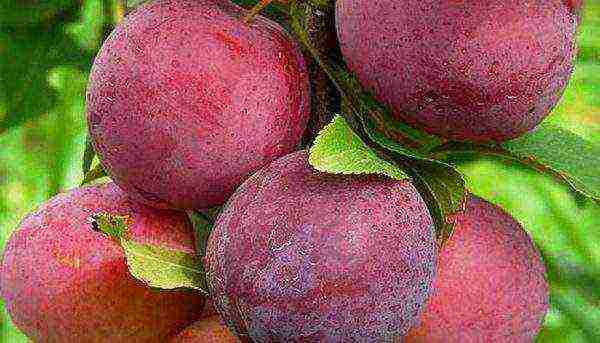 Cherry plum Found
Cherry plum Found
The variety is of medium ripening, the tree grows to medium size, the crown is dense, round, slightly flat. Fruit weight reaches 35-37 grams, the pulp is rich yellow, the taste is pleasant, refreshing, sweet and sour. A tree can bring its first harvest as early as 3 years, and after some time, up to 40 kilograms of delicious fruits can be harvested from one tree. The variety tolerates both winter and spring temperature drops, average drought resistance. Pollination occurs with the help of other varieties blooming in the same period as Naydena.
Huck
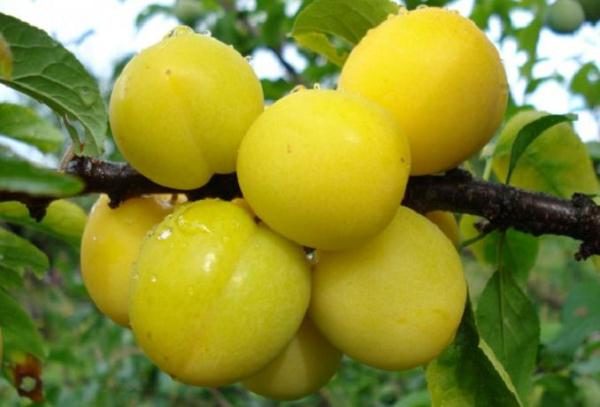 Cherry Gek
Cherry Gek
A variety that bears fruit in medium terms. The tree grows very quickly, but at the same time reaches an average height, the crown is dense, slightly drooping, rounded. Fruits weigh up to 35 grams, the color of the pulp is dark yellow, the taste is sweet and sour, the stone is difficult to separate... The purpose of such cherry plum allows you to use it in any form. The winter hardiness of the variety is good, the same applies to the yield, which pleases with its high stability. Pollination is cross with other trees growing near cherry plum.
Monomakh
 Alycha Monomakh
Alycha Monomakh
The fruits of this variety are inferior in size to other varieties and weigh only 25-30 grams.but the distinctive feature will be excellent taste, juiciness and easy pitting. Also, this cherry plum has an unusual shape, reminiscent of a Monomakh hat and a rich, purple skin color. The harvest ripens early, the tree bears fruit annually and in large quantities.
The most frost-resistant cherry plum varieties for the central and middle lane
To grow cherry plum in Central Russia, you need to carefully consider the frost resistance of the variety. Trees should not only survive the cold winter well, but also the spring frost, because the main threat of an unstable climate lies precisely in them. The best indicators have varieties: Tsarskaya, Seanets Rocket, Vladimir comet and others.
Gift to St. Petersburg
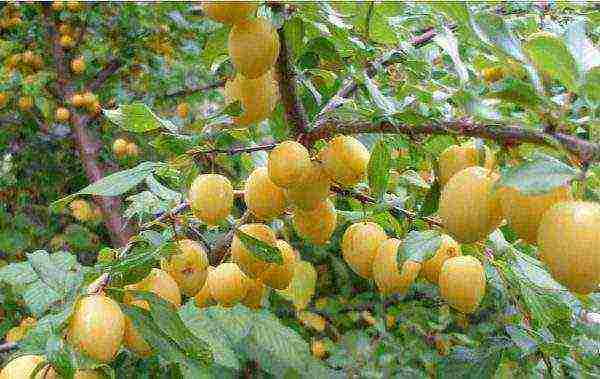 Alycha Gift to St. Petersburg
Alycha Gift to St. Petersburg
The variety is distinguished by good resistance not only to cold weather, but to unstable climatic conditions, heavy rainfall and frost. A tree of medium size, with a wide, dense crown of large size, the first fruits are already at 4 years of age. The yield is annual. Fruits are light orange in color, slightly elongated in weight, reaching only 20 grams... The taste is sweet and sour, and the fruits also tolerate transportation well and can be used for various types of preservation.
Vladimir comet
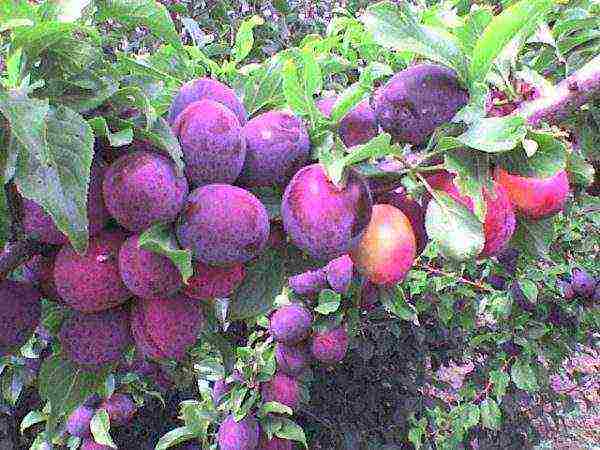 Alycha Vladimirskaya comet
Alycha Vladimirskaya comet
This variety was bred relatively recently, but already surpasses many old subspecies in all respects. A medium-sized tree has a wide, but at the same time, sparse crown. Fruits are large in size, round-oval in shape with a pointed end, the skin color is burgundy, there is a light waxy bloom... The pulp is a rich, dark orange shade with a sweet and sour taste. The purpose of such cherry plum is universal. The tree quickly begins to bear fruit and also quickly increases its yield; you can harvest ripe cherry plum already in mid-July. Frost resistance is very high, the same applies to the self-fertility of the variety.
Rocket Seedling
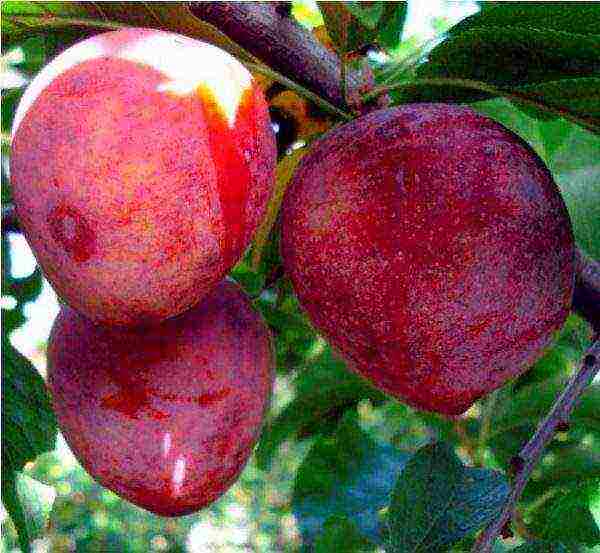 Cherry Seedling Rocket
Cherry Seedling Rocket
The variety is distinguished by exceptional frost resistance, a medium-sized tree can withstand frosts down to -35 degrees. The crown of the tree is dense, spreading. Fruits are large, grow up to 30 grams, red color, rounded shape with pointed ends... The yield of the variety is at the highest level.
Timiryazevskaya
 Alycha Timiryazevskaya
Alycha Timiryazevskaya
The variety got its name in honor of the scientific institute in which it was bred. The tree grows to a height of no more than 3 meters, the crown is spreading, resembles a cone in shape, foliage is very rare. The fruits are small, ovoid, covered with a thin skin of light red color. The pulp is very tasty and juicy, loose, fibrous, the stone is separated without difficulty. Up to 30 kilograms of fruit can be harvested from one tree., while it does not require complex care, tolerates frost well and is not affected by fungal diseases.
Self-fertile varieties of Russian plum
It is extremely inconvenient to grow cherry plum varieties that need additional pollination. This creates unnecessary trouble or you have to plant several varieties of the same crop in one area, which is extremely inconvenient for small farms and those gardeners who want to collect a variety of fruits. The following self-fertile varieties have proven themselves best.:
Kuban comet
 Cherry plum Kuban comet
Cherry plum Kuban comet
Perfect for growing on subsidiary plots, a tree of low growth annually brings abundant harvests of up to 40 kilograms. Fruits with a reddish, ruddy skin and yellow pulp weigh up to 28 grams, the taste is kilo-sweet, are suitable for fresh consumption and for various types of processing. The bones are very difficult to separate. The variety does not require additional pollination; both wood and flower buds tolerate frosts. The tree requires timely watering.
Traveler
 Cherry Traveler
Cherry Traveler
Acts as a pollinator for other varieties, but at the same time annually brings crops up to 40 kilograms... A tree of medium growth with an ordinary crown begins to bear fruit at 3 years of age, the ripening period is average. Traveler fruits can weigh up to 30 grams, the pulp is colored dark yellow, this variety is characterized by a light banana flavor. Frost resistance is high, as well as drought resistance.
Mara
 Alycha Mara
Alycha Mara
Self-fertile variety, perfect for growing in central Russia, tolerates frost well and is immune to many diseases. A tree that grows up to 2-3 meters has a beautiful crown resembling a ball, so formative pruning must be carried out regularly. Fruits ripen in early July and can hang without dropping until early August... The skin color is rich, yellow-orange, the skin is slightly lighter. The taste is pleasant, fibrous, very sweet, this variety is perfect for cooking preserves and jams.
The best varieties for growing in summer cottages in the Moscow region
In order to grow cherry plum in the Moscow region, you need to choose the right varieties that can withstand the changeable climate, but at the same time will be easy to care for. Most often in the dachas of the Moscow region there are:
Columnar
 Cherry plum Coloniform
Cherry plum Coloniform
Perhaps the most unusual and compact cherry plum variety. The tree grows up to 3 meters in height, while the crown diameter does not exceed 1.5 meters. The variety is not afraid of frost and very quickly recovers after freezing, while other species begin to wither and slowly die. The fruits are very large, their weight can reach 40 grams, the skin of a deep red color with a light waxy bloom, is not afraid of heavy rainfall and is not prone to cracking. The pulp is tasty, juicy, fibrous.
Ruby
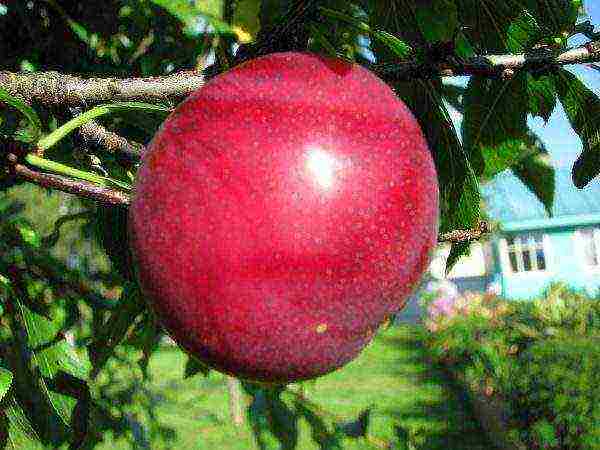 Cherry plum Rubinovaya
Cherry plum Rubinovaya
A small tree does not require complex maintenance and perfectly adapts to any weather conditions. The variety does not suffer from sudden changes in temperature and at the same time bears bright burgundy fruits with dark yellow, honey pulp. The cherry plum, ripening in the middle of summer, has no sourness in its taste, which is very attractive for lovers of sweet fruits.
Gold of the Scythians
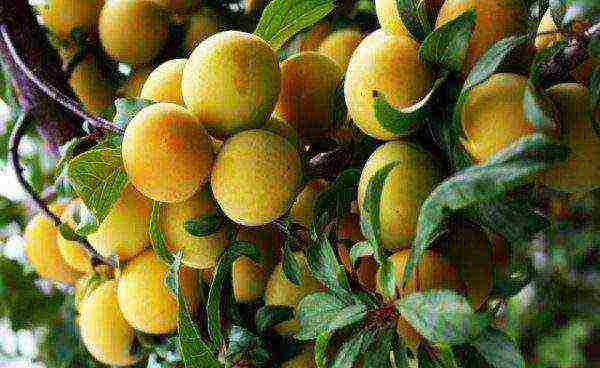 Cherry plum Gold of the Scythians
Cherry plum Gold of the Scythians
The variety was bred in 2005 and is a tree that grows to a height of no more than 3 meters with a crown shaped like a wide cone. Large fruits have a rich, golden skin color... The pulp is very sweet, juicy and tender. The tree is not afraid of a sharp change from cold to heat and vice versa, does not require long-term attention to itself, while the Scythian Gold variety bears fruit very early and annually. The size of the harvested crops is average, it needs additional pollination.
Early
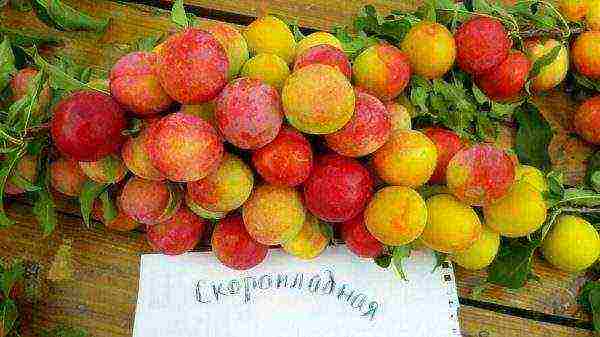 Cherry plum Skoroplodnaya
Cherry plum Skoroplodnaya
A variety of Chinese selection. The tree is small, already at 2-3 years of age, it can bring the first harvest of medium-sized reddish fruits. The pulp is very pleasant, tender and tasty, the stone is easily separated, which is why such fruits are well suited for fresh consumption. Possesses resistance to frost and gusty winds, requires planting a pollinator tree next to it.
Achievements of modern breeding allow grow cherry plum not only in the southern regions, but also in the central part of Russia... If desired, every gardener can try to grow a tree with excellent and tasty fruits on his site.
More than 100 varieties of cherry plum have been bred by breeders. All these varieties differ:
- By the timing of ripening.
- The size, color and taste of the fruit.
- Productivity.
- Winter hardiness.
- The size and shape of the trees.
This page contains descriptions of the most famous and popular varieties of cherry plum or "Russian plum". There are photos of each variety, characteristics and brief recommendations for planting and care.
Self-fertile varieties of cherry plum
Most varieties of plums and cherry plums are themselves sterile. For high-quality pollination, you have to plant at least two trees of different varieties, but blooming at the same time. However, several varieties of cherry plum are self-pollinated and can be planted singly.
Kuban comet
Kuban comet
Kuban comet - mid-early, self-fertile variety of cherry plum. Cross-pollination is optional, but desirable.
- The yield is high, up to 50 kg. fruits from each tree. Bears fruit annually.
- Fruits weighing 30 - 40 grams. sweet and sour taste, ripens in mid-July - early August.
- Low-growing trees 2 - 2.5 meters.
- Fruiting begins 2-3 years after planting.
- High winter hardiness, recommended for growing in the middle lane, the Moscow region and the North-West region.
- The variety is resistant to major diseases.
There is also a late comet, this is a variety of the same variety, which ripens at the end of August. Since the Kuban comet is self-fertile, it will bear fruit without any pollinators. But if another cherry plum or Skoroplodnaya plum grows nearby, the yields will be much more significant.
Advantages: self-pollination, frost resistance, high and stable productivity, average drought resistance, extreme unpretentiousness. The comet can grow on any soil, treatment from diseases and pests is practically not required. The trees are not tall, easy to work with.
Flaws: the seeds are poorly separated, but this is a common disadvantage for all varieties of cherry plum. Branches often break from the abundance of fruits.
Reviews: only positive, the Kuban comet has proven itself well in all regions, from south to north. This variety is considered by many to be the best.
Cleopatra
Cleopatra
Cleopatra - late, partially self-fertile variety of cherry plum. In the presence of cross-pollination, the yield will be 2 - 3 times higher.
- Average yield, stable fruiting.
- The taste of the fruit is sweet and sour, weight 30 - 35 g. ripen in September.
- The tree is medium-sized with a height of 3 - 4 meters.
- Early maturity is average, usually the first harvest occurs in the fourth year after planting.
- High winter hardiness, this cherry plum variety is recommended for growing in the Moscow region and the middle lane.
- Good disease resistance.
To obtain a high yield, it is recommended to plant 1 - 2 other varieties of cherry plum or Chinese plum next to Cleopatra.
Characteristics of early varieties of cherry plum
Traveler
Traveler
Traveler - mid-early, self-fertile variety of cherry plum.
- Productivity 30 - 40 kg. from an adult tree, fruiting is stable, annual.
- Fruits of medium size, weighing 20 - 25 grams, taste sweet and sour, ripen in July.
- The tree is medium-sized with a height of 3 - 4 m.
- Early maturity is good, fruiting begins in the third year after planting.
- High winter hardiness, this variety can be grown in the middle lane and the Moscow region.
- Good resistance to viral diseases.
Advantages: early maturity, winter hardiness, consistently high yield, early ripening of fruits, good resistance to pests and diseases.
Flaws: relatively small fruits that fall off when overripe and are not suitable for long-term transportation. Freezing of fruit buds is possible during early flowering.
Found
Found
Found - a high-yielding, early-ripening variety of cherry plum.
- Productivity 35 - 40 kg. from every adult tree.
- Fruits weighing about 30 grams. sweet taste and juicy pulp, ripen in July.
- The trees are medium-sized, with a height of 3 to 5 meters.
- Saplings begin to bear fruit 2 to 3 years after planting.
- Good winter hardiness, it may well be cultivated in the middle lane and the Moscow region.
- Excellent resistance to pests and diseases.
Advantages: tasty, juicy fruits that do not crack or fall off when ripe. Consistently high yield, frost resistance and early maturity.
Flaws: self-fertility, it is necessary to plant several different varieties of cherry plum for cross-pollination.
Gift to St. Petersburg
Gift to St. Petersburg
Gift to St. Petersburg - mid-early variety of yellow cherry plum.
- Average yield of an adult tree is 30 kg.
- Small cream, weighing 12 - 15 grams, sweet and sour taste, ripening begins at the end of July.
- The trees are not tall, with a wide-spreading weeping crown (height 3 - 4 m.)
- Saplings begin to bear fruit only from 4 to 5 years after planting.
- Excellent winter hardiness, recommended for growing not only in the middle lane, but also in the northern regions.
- Good disease and pest resistance.
Advantages: it is characterized by consistently high yields, unpretentiousness and frost resistance.
Flaws: small fruits, when fully ripe, shedding is possible, self-infertility.
The varieties Pavlovskaya Zheltaya and Pchelnikovskaya are recommended as pollinators.
Gold of the Scythians
Gold of the Scythians
Gold of the Scythians - mid-early, self-fruitless variety of yellow cherry plum.
- Average yield, 20 - 25 kg. fruits from an adult tree. Not every season bears fruit, there are years when the tree rests.
- The cream is large, the average weight of each is 30 - 35 grams. Ripening begins at the end of July, the taste of the fruit is sweet and sour.
- The height of the trees is 3 - 4 m, the crown is spreading, sparse.
- The first harvest can be tried 4 - 5 years after planting the seedling.
- High winter hardiness, can be grown in the middle lane and the Moscow region.
- Disease resistance is weak.
Advantages: high winter hardiness and excellent taste.
Flaws: often affected by diseases and pests, the need to plant several trees.
Nesmeyana
Nesmeyana
Nesmeyana - tall, early variety of red cherry plum.
- The yield is average.
- Cream is red, round in shape, weighing about 30 grams, ripens in July.
- The tree is tall, with a spreading, sparse crown, up to 5 - 6 meters high.
- Begins fruiting in 3-4 years.
- High frost resistance, can be grown in the middle lane and the Moscow region.
- Poor disease resistance.
Advantages: high winter hardiness, delicious cream.
Flaws: cross-pollination is necessary, often sick.
The best pollinators are the Kuban comet, Traveler, Cleopatra.
Breeze
Breeze
Breeze - mid-early, high-yielding variety of cherry plum.
- An adult tree gives 35 - 40 kg. delicious, juicy fruits.
- Cream of medium size, weighing 30 - 35 g, pleasant sweet and sour taste, ripens in late July - early August.
- Trees from 3 to 5 meters high, with a rather sparse crown.
- The first harvest can be tried 2 - 3 years after planting.
- Good winter hardiness.
- The wind is resistant to major diseases and pests.
You can use Comet, Solnyshko, Lodva as pollinators.
Tent
Tent
Tent - highly winter-resistant, early variety of cherry plum.
- Enviable yield, 35 - 40 kg can be harvested from one adult tree. fruits.
- Cream weight 35 g, sweet taste 4.5 points, ripen in mid-July.
- The trees are not tall - from 2 to 3 meters.
- They enter fruiting quite late, 3 - 5 years after planting the seedling.
- A highly winter-resistant variety, can be grown in the middle lane and the Moscow region.
- Resistant to major diseases and pests.
Advantages: cold resistance, practically does not get sick, undersized trees are convenient for work, tasty and large cream, extended ripening period.
Flaws: seeds are poorly separated, cross-pollination is necessary, due to early flowering, fruit buds may freeze.
The pollinator can be any other variety of cherry plum that blooms at the same time as Tent.
Flint
Flint
Flint is a mid-early cherry plum variety.
- The yield is average.
- Round cream, weighing 20 - 25 g, sweet and sour in taste, ripens in mid - late July.
- Trees from 3 to 5 meters high with a dense crown.
- Average winter hardiness.
- Resistance to major diseases and pests is good.
Advantages: fruits are ideal for canning and transport well.
Flaws: poor winter hardiness, the need for cross-pollination.
Description of cherry plum varieties of average ripening
The middle ones are considered to be varieties that ripen in August.
Chuk
Chuk
Chuk - a self-fertile variety of cherry plum of medium ripening.
- Average yield, about 30 kg. fruits from one tree.
- Sweet and sour cream, weighing about 30 grams, ripens in August.
- Trees 3 - 4 meters high.
- The first harvest can be tried 3-4 years after planting.
- Chuk's frost resistance is average.
- Good disease resistance.
Advantages: tasty, large fruits, good and regular yield.
Flaws: low winter hardiness, average drought resistance, self-fertility.
Other varieties of cherry plum or Chinese plum will help provide cross-pollination.
Llama
Llama
Llama - medium late, frost-resistant cherry plum variety.
- High yield, 40 - 50 kg can be harvested from each adult tree.
- The cream is large, weighing on average 30 - 40 grams, the taste is sweet and sour, ripens in mid-August.
- The trees are low, about two meters high.
- The early maturity is high, the seedlings begin to bear fruit 2 - 3 years after planting.
- High winter hardiness, recommended for growing in the middle lane, the North - Western region and Siberia.
- Good resistance to major diseases and pests.
There are a lot of advantages: excellent winter hardiness, early maturity, drought resistance, large and tasty fruits, remarkable productivity, seeds are easily separated from the pulp, ornamental trees with reddish leaves.
Flaws: in windy or rainy weather, ripe cream falls off easily, cross-pollination is necessary.
The best pollinators are such varieties as Asaloda, Mara, Vitba.
General
General
General - a large-fruited variety of cherry plum of medium ripening.
- The yield does not exceed 20 - 25 kg. from one tree.
- But the cream is very large and tasty, the average weight is 45 - 50 grams. and even more. Ripening begins in mid-August.
- The trees are tall, up to 6 meters.
- The fruitfulness is high, already at 2 - 3 years the seedlings begin to yield.
- Frost resistance is not good enough, for the middle zone, and even more so for the northern regions, this variety is hardly suitable.
- Resistant to disease.
Advantages: the main feature of this variety is very large fruits, consistently good yield, early maturity.
Flaws: insufficient winter hardiness.
Columnar
Columnar
Columnar - large-fruited cherry plum of medium ripening.
- The yield is consistently high.
- Large cream weighing 40 gr. and more, ripen in August.
- The trees are columnar, about 3 meters high and a crown diameter of no more than 1.5 meters.
- Seedlings begin to yield 3 to 4 years after planting.
- Frost-resistant variety, can be grown in the middle lane and the Moscow region.
- Resistance to pests and diseases is also high.
Advantages: compact trees take up little space, regular and abundant fruiting, large cream, high winter hardiness.
Flaws: self-infertility, which means it is necessary to plant pollinator varieties.
Tsarskaya
Tsarskaya
Tsarskaya - a yellow variety of cherry plum of medium ripening.
- Average yield, 20 - 25 kg. from every tree.
- A medium-sized cream, weighing 20 - 25 grams, ripens in early August.
- The trees are not very tall, 2, 5 - 3 meters.
- Saplings begin to bear fruit as early as the second year after planting.
- Average winter hardiness.
- Resistance to common diseases is good.
Advantages: early maturity, transportability and keeping quality of fruits, ease of cultivation.
Flaws: insufficient frost resistance, forms a lot of growth, self-fertility.
Review of late ripening cherry varieties
Cherry plum, which ripens in September, is considered later.
Mara
Mara
Mara - yellow cherry plum of late ripening.
- Mary's yield is high, up to 50 kg are harvested from an adult tree. fruits.
- Medium-sized cream, weight 25 g, sweet and sour taste, ripens in September.
- Trees up to 5 - 6 meters high, grow quickly.
- It begins to bear fruit quite early, and it will be possible to taste the first cream already for 2 - 3 years.
- Excellent frost resistance, recommended for planting in almost all regions.
- Resistant to diseases and pests.
Advantages: high and stable productivity, excellent winter hardiness, unpretentiousness and resistance to pests. The harvested fruits can be stored for a long time without loss of marketability.
Flaws: the pulp is difficult to separate from the seeds, cross-pollination is necessary.
The best pollinator is Vitba cherry plum.
Gift to Primorye
Gift to Primorye
Gift to Primorye - late, self-fertile variety of cherry plum.
- The yield of this "Russian plum" is 30 kg. fruits from the tree.
- The cream is large, the average weight is 30 - 35 g, the taste is sweet and sour, ripening begins in late August - early September.
- The height of the trees is 3 - 4 meters, the crown is of medium thickening.
- Saplings begin to bear fruit for 3-4 years. The tree has a lifespan of at least 25 years.
- High winter hardiness, this cherry plum variety is recommended for cultivation in the Far East and Siberia.
- Resistance to major diseases is good.
Advantages: large, tasty cream that can be easily transported, good and regular yields, the ability to easily endure severe winters, drought tolerance.
Flaws: poorly tolerates waterlogging, with a bountiful harvest, branches can break, pollinators are required.
Soneyka
Soneyka
Soneyka - yellow cherry plum of medium ripening.
- Soneika's yield is 30 - 40 kg. cream from each tree.
- Fruits are very large, weighing 40 to 50 grams, sweet and sour taste, ripen in early September.
- The trees are not tall, about 3 meters high.
- The variety is early-growing, the first harvest is obtained already 2 - 3 years after planting the seedlings.
- Winter hardiness is sufficient for growing in the middle lane.
- Good resistance to diseases, pests.
Video about planting and growing cherry plum
In case of cross-pollination, pollinating varieties should grow no further than 50 m from the main varieties. If your neighbors already have cherry plum growing on the plot, then even planting only one tree, you will not be left without a crop.
Save article to:
Dear visitors of the "Dacha Plot", tireless gardeners, gardeners and flower growers. We offer you to pass the aptitude test and find out whether you can trust the shovel and let you into the garden with it.
Test - "What kind of summer resident I am"
Share this article with your friends:
In the southern regions, with their mild climate, wild cherry plum grows everywhere. In the northern regions, in the middle lane, as well as in the Moscow region, under natural conditions, it cannot grow, since it is not characterized by winter hardiness. But it easily crosses with a regular plum, more resistant to frost to sudden changes in temperature and frost. In the article we will tell you about the best varieties of cherry plum for the Moscow region, we will give their detailed description.
In the Moscow region, you can grow different varieties of cherry plum
Growing cherry plum in the Moscow region
It was the plum that served as a stock for breeding hybrid forms and new varieties of thermophilic cherry plum for the Moscow region. Today cherry plum is divided into several groups, which are varieties of wild cherry plum growing in the southern climatic zone. Back in the last century, domestic breeders developed a hybrid form based on the Chinese plum, from which new winter-hardy varieties were obtained.
Now breeders have given these varieties an informal joint name - "Russian plum" - an ordinary plum with a specific sour taste. Cherry plum varieties for growing in the Moscow region have the best qualities obtained from plums - high winter hardiness and large-fruited, and directly from the cherry plum itself - an excellent taste.
The plant is easily crossed with different types of plums, which allows you to get more and more new varieties. For most of those bred for the Moscow region, they have early ripening periods. This makes it possible to harvest until the autumn frosts. Such varieties have increased winter hardiness, high yields, resistance to diseases and pests, and are mostly self-fertile. Read also the article: → "Rules for pruning cherry plum in spring and autumn: diagram, step-by-step instructions."
★ The best hybrid varieties of cherry plum for the Moscow region
The most important criterion for growing hybrid species of cherry plum is the climate. Consider suitable varieties:
| Variety name | Characteristic |
| Kuban comet | Mid-season variety. The berries ripen in early August. They are bright yellow in color, large. The middle is fine-fiber, juicy, sweet and sour, not separating from the stone. High productivity. |
| Ruby | The variety is winter-hardy and drought-resistant variety. The harvest can be unstable due to weather conditions. Large fruits weighing 30-35 g, They have a sweet and sour taste. |
| Timiryazevskaya | An early ripe variety with high winter hardiness. Orange with a reddish tinge, small, ovoid fruits with sweet flesh with a honey flavor. The bone is easily separated from the pulp. The rind is thin. The yield is stable - up to 30 kg per tree. Resistant to fungal diseases. |
| Gold of the Scythians | The variety is early maturing. Light yellow fruits are large, juicy, sweet. Weight 40 g. Trees are spreading, up to 2 m high. |
| Cleopatra | Late-ripening variety. Resistant to frost. High-yielding. Large fruits weigh 37-40 g. Dark red. Have a purple waxy coating. The middle is red, with fine fibers, fleshy, moderately sweet. The variety is resistant to many diseases. |
| Early | An early ripe winter-hardy variety. Fruits are small, red-orange, large with yellow juicy, fragrant and sweet pulp, with a small stone, easily separating. |
| Mara | Self-pollinated winter-hardy variety, resistant to fungal diseases. Small, round, yellow fruits. Their weight is 20-23 g. The taste is sweet and sour. For 7 years of cultivation, it yields up to 40 kg of fruits from a tree. |
Harvested well in warm weather
★ Rating of the best varieties of cherry plum for the Moscow region
The following varieties can be grown in the Moscow region:
| Variety name | Characteristic |
| Nesmeyana | The mid-season variety is relatively new. The tree is tall, spreading with strong branches. Large fruits are purple-red in color. The pink center is dense, fibrous. Easily detachable bone. The taste is sweet with a slight sourness. Does not self-pollinate. The yield is average. Not resistant to disease. Transportable, stable. Used for making wines. |
| Gift to St. Petersburg | A variety of yellow cherry plum. The tree is weak, the crown looks like a weeping willow. Egg-shaped yellow-orange small fruits are sweet and sour, juicy. The bone is not separated from the pulp. Fruiting is stable and abundant. Yields up to 60 kg of harvest per tree. The variety is transportable. |
| Ruby | The fruits ripen at the end of July. They are bright burgundy with a juicy amber center. They have a fruity aroma, sweet. The variety is very winter hardy. |
| Anastasia and Huck | These varieties have very tasty and large fruits weighing 32 g. The varieties are resistant to diseases. |
| Dessert | The fruits are large. They are beautiful and delicious. With a dense skin that has a waxy coating. |
| Evgeniya | The variety is distinguished by very large fruits. They are moderately juicy, with a slight sourness. They are good fresh and for preparations. |
| Pioneer | The fruits are very beautiful and delicious. With a small bone, fragrant pulp, thin skin. |
| Pearl | The fruits are large. Their weight is 30 g.the middle is dense. A taste for an amateur. Suitable for making compotes. |
| Purple | Medium-sized orange berries, very juicy, with small seeds, difficult to separate from the pulp, with a thin skin. |
| Purple dessert | The berries of this variety are very large. Their weight can reach 40 g. The pulp is bright orange, juicy. The skin is dense with a waxy coating. Ripens in mid-July. |

Cherry plum variety Pionerka
★ Self-fertile varieties of cherry plum for the Moscow region
We must admit right away that most of them are self-fertile only partially. They bear fruit better if trees of a different variety grow nearby. The best pollinators are varieties: Pramen, Mara, Gift to St. Petersburg. By the way, the latter blooms for two whole weeks and can pollinate both early and late varieties.
Tip # 1. Cherry plum trees of the same variety growing on the site do not give complete information about the taste and color of the berries. Therefore, you need to experiment.
Experienced gardeners recommend choosing:
- Strong seedlings of zoned varieties.
- Fast-growing varieties (they enter fruiting in two years).
- Self-fertile varieties, if others do not grow nearby.
| Variety name | Characteristic |
| Sigma | The fruits of this variety are very similar to cherries. Wide oval. They are fragrant and delicious. The color is violet-red, there is a waxy coating. The pulp is of medium density, yellow, sweet and sour. The bone is not separated from it. |
| Huck | Medium late grade. The tree is 2 m high. The crown is dense, flat-round. The fruits are yellow outside and inside, sweet and sour, large. Weight 31 g. The variety is high-yielding, winter-hardy. Transportable. |
| Kuban comet | The variety is frost-resistant. Fruits are lilac-claret, large, oblong. The pulp is of medium density, juicy, sweet. |
| Sarmatka | The variety is fast-growing. Berries are ovoid, burgundy with a light waxy coating. Beautiful, tasty, sweet and sour. The pulp is yellow, medium density. |
| Traveler | Frost-resistant early ripening variety. Berries are medium in size. They weigh 25-30 g. Bright yellow, very fragrant, juicy. The pulp is fine-fibred. The taste is sweet and sour. The bone is poorly separated from the pulp. The variety is drought-resistant. |
| Granite | Medium late grade. Winter hardy. Fruits with a waxy coating, juicy. The pulp is yellow. |
| Chuk | The variety is fast-growing. Winter hardy, high-yielding. Fruits maroon with orange pulp weigh 28 g. The middle is fragrant, dense, juicy. |
| Tent | Early ripe variety. Winter hardy. High-yielding. Weak tree. Yellowish-green with red sides, burgundy when ripe, the berries are large with a yellow dense middle. With a weak aroma, sweet and sour pleasant taste. With an inseparable bone. |
| Avalanche | Medium late grade. Winter hardy. Harvestable. The berries are large, yellow, shiny, with dark red sides. The middle is of medium density, yellow, aromatic, juicy, sweet and sour. The bone is separated freely. |
| Yarilo | Very early maturing variety. The fruits are red, shiny, large. Weight 30 g. The middle is fibrous, yellow, juicy, dense, fragrant. Sweet and sour taste. Large bone, semi-detachable. |
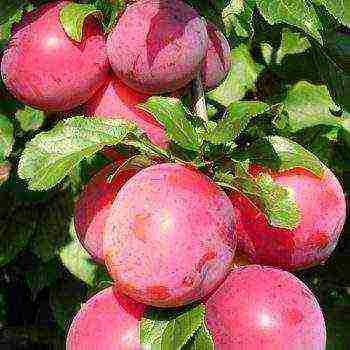
Cherry plum variety for the Moscow region called Kuban Comet
Gardeners' mistakes when growing cherry plum
Incorrect fit. Cherry plum trees will die if they are planted in deep holes filled with fertile loose soil in the lower part of the site. As a result, the plants will grow strongly and settle from their own gravity, rain and melt water will stagnate in them. Then - to rot the bark at the bottom of the boles. See also the article: → "Methods of combating clasterosporium disease on fruit trees and shrubs."
The experience of growing cherry plum in the suburbs of gardeners is still small. It has not yet experienced extreme conditions of unfavorable winters with very low temperatures, with sudden cold snaps after sharp warming.
Tip # 2. It is worth growing different crops and watching them grow and develop depending on the weather conditions.
One of the main mistakes even experienced gardeners make is the desire to buy the largest seedlings. Most often, the largest seedlings are the worst. The fact is that plants in nurseries are dug up with a plow, which in a large seedling leaves only half of the suction roots, or even less. In order for such seedlings to take root in a new place, almost all of its crown should be removed. In addition, such plants will be sick for a very long time.
And in small, ugly seedlings, the crown is not yet developed, or is absent at all, but the roots are much less damaged when excavated. Such seedlings take root much faster and in the future will outstrip much three-year-old seedlings in growth. You should not buy seedlings at spontaneous markets or from cars that call into gardening sites along the road. Buy seedlings exclusively zoned and only in the nursery, those that are zoned for your climate.
Another mistake is buying and planting very early seedlings that have an open root system. Seedlings of most horticultural crops are planted from September 15 to October 5-10. For cherries and plums - until September 25th.
When choosing a cherry plum variety, pay attention to all the little things of the plant.
Heading "Question-answer" about growing cherry plum
Question number 1. How can a rainy summer be reflected on cherry plum?
Due to the lack of heat, the fruits of many crops have significantly deteriorated their qualities (taste, marketable). But the prolonged rains did not affect the cherry plum in any way. Some of its fruits were even much larger than usual. With a strong waterlogging of the soil, the fruits of many crops usually crack, rot and become inedible.
Cherry plum can also crack, but if such fruits are removed in time, they remain very suitable for consumption. In addition, do not forget that cherry plum is less susceptible to fungal diseases, in particular, fruit rot, but only if there is no thickening inside the crown and between plantings. Read also the article: → "How to treat the garden in autumn, and what additional measures should be taken to protect the trees?"
Question number 2. Does cherry plum need a pollinator?
According to scientific sources, some varieties of cherry plum are partially self-fertile. But it is better not to count on this partialness. You just need to plant 2-3 flowering varieties next to each other at the same time or arrange them by grafting in the crown. If you liked only one variety, or there is no room on your site, other varieties can only be grafted with one branch - its flowering will be enough to pollinate the entire tree.
Question number 3. What are the features of growing cherry plum?
Many new varieties of cherry plum are winter hardy. One of the main features of cherry plum is its rapid growth. Experienced gardeners recommend shortening strong growth shoots so that they have time to ripen. However, there are experts who dispute this method. In spring, cherry plum buds can freeze slightly. The rest of the cherry plum is very attractive for cultivation. Begins fruiting 3-4 years after planting. Bears fruit annually and abundantly. The culture is relatively resistant to diseases and pests. Neutral to the close standing of waters.
Rate the quality of the article. We want to be better for you:
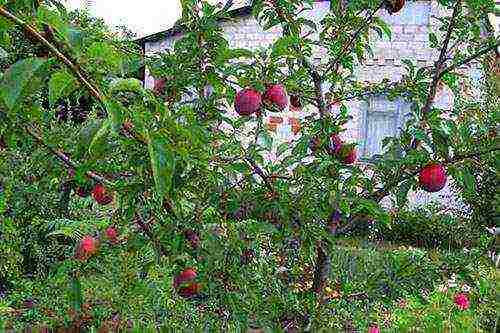
The possibilities of breeding and successful experiments with the breeding of varieties of fruits have led to the fact that for many years a whole galaxy of beautiful varieties of cherry plum has been grown for the Moscow region. For the climatic conditions of the middle zone, winter-hardy varieties of cherry plum have been bred, capable of withstanding winter cold, summer heat, sharp temperature drops in spring. Impressive harvests are harvested every year. A wonderful cherry plum for the Moscow region, its best varieties have successfully received the well-deserved assessment of gardeners as the best fruits in the region.
What kind of cherry plum we grow
It has been noticed that large fruits have a pleasant taste. The same goes for cherry plum. Varieties with large fruits and a good indicator of frost resistance.
Alycha Mara
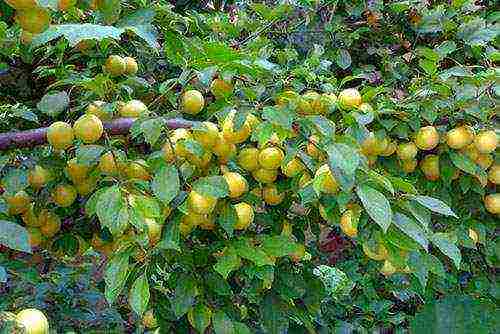 Fast growing tree. Suffers frost.Loves a sunny, bright place. In the summer, when the water is stagnant, it is necessary to drain the soil so that the excess water is gone. Without this, the plant may die. It is advisable to plant it on loam. Fruits are round, up to 23 gr. Juicy, bright yellow. The bone is difficult to separate. Harvesting in September. Two to three years after planting, it gives good yields. Produces large harvests only after 5 years. A hectare of Mara cherry plum gives 35 tons. Pollinated with other varieties. It cannot pollinate itself.
Fast growing tree. Suffers frost.Loves a sunny, bright place. In the summer, when the water is stagnant, it is necessary to drain the soil so that the excess water is gone. Without this, the plant may die. It is advisable to plant it on loam. Fruits are round, up to 23 gr. Juicy, bright yellow. The bone is difficult to separate. Harvesting in September. Two to three years after planting, it gives good yields. Produces large harvests only after 5 years. A hectare of Mara cherry plum gives 35 tons. Pollinated with other varieties. It cannot pollinate itself.
Cherry Traveler
 Early ripening, unpretentious variety. Withstands the winter cold, resistant to many diseases in the area where it grows. Medium height. The crown is not too dense, the leaves are pale green, glossy. The bloom is bright, the aroma from the flowers diverges for tens of meters around. The flowers are white, large. Fruits are round, medium in size, weighing 20-30 grams, purple-red, smooth to the touch. Delicate, sweet-yellow juicy pulp. Difficult to separate bone. Every year this variety pleases with large harvests. Adapts to all types of soil. Prefers a light, windless area with close groundwater. Loves loam. Plant in spring.
Early ripening, unpretentious variety. Withstands the winter cold, resistant to many diseases in the area where it grows. Medium height. The crown is not too dense, the leaves are pale green, glossy. The bloom is bright, the aroma from the flowers diverges for tens of meters around. The flowers are white, large. Fruits are round, medium in size, weighing 20-30 grams, purple-red, smooth to the touch. Delicate, sweet-yellow juicy pulp. Difficult to separate bone. Every year this variety pleases with large harvests. Adapts to all types of soil. Prefers a light, windless area with close groundwater. Loves loam. Plant in spring.
Cherry plum Found
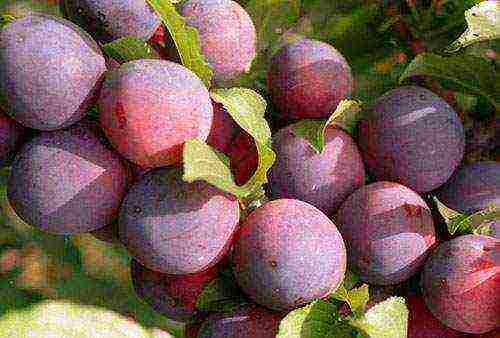 Not large, not small, medium dense tree with a rounded, flattened crown. The bud opens with two flowers. When ripe, the dense branches are hung with frequent fruits. Fruits are medium to large in size. The outer color is red-violet, with yellowness. They weigh 35 - 37 grams. The pulp is yellow or orange, the pulp density is medium. Has a sweet and sour, fresh taste. Begins to bear fruit at 3 years old. Subsequently, 30 - 40 kilograms of the crop are harvested from the tree. The variety is resistant to temperature extremes and frost. Drought tolerates almost normally.
Not large, not small, medium dense tree with a rounded, flattened crown. The bud opens with two flowers. When ripe, the dense branches are hung with frequent fruits. Fruits are medium to large in size. The outer color is red-violet, with yellowness. They weigh 35 - 37 grams. The pulp is yellow or orange, the pulp density is medium. Has a sweet and sour, fresh taste. Begins to bear fruit at 3 years old. Subsequently, 30 - 40 kilograms of the crop are harvested from the tree. The variety is resistant to temperature extremes and frost. Drought tolerates almost normally.
Cherry plum is pollinated. Found in cross with other varieties. Suitable for conservation.
Alycha Gift to St. Petersburg
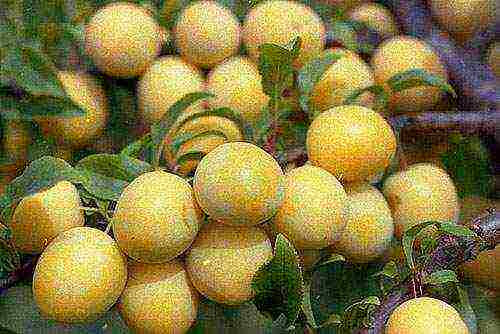 Remains unharmed at 30 degrees below zero. Withstands temperature extremes well. The tree is not too large, up to 3 meters in height, spreading. Dense crown. Light green oval leaves, boat. The edges of the leaves are patterned. Begins to bear fruit for 4 years. Differs in high productivity. The harvest is good every year. Fruits are elongated, weighing up to 20 grams. Outwardly light orange. They are remembered for good taste. The inside is sweet and sour, the flesh is finely fibrous. Convenient to preserve, transport.
Remains unharmed at 30 degrees below zero. Withstands temperature extremes well. The tree is not too large, up to 3 meters in height, spreading. Dense crown. Light green oval leaves, boat. The edges of the leaves are patterned. Begins to bear fruit for 4 years. Differs in high productivity. The harvest is good every year. Fruits are elongated, weighing up to 20 grams. Outwardly light orange. They are remembered for good taste. The inside is sweet and sour, the flesh is finely fibrous. Convenient to preserve, transport.
Cherry plum Coloniform
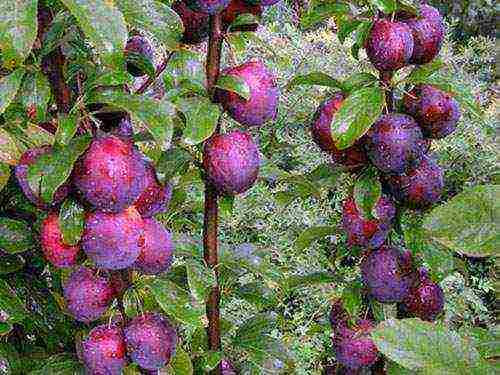 This variety contains all the good that many varieties of cherry plum have. Short stature. Columnar crown. The tree takes up little space. Grows up to 2.5 meters up. Variety resistant to pests and diseases. Harvest with large egg-shaped fruits. Burgundy-purple, dense, sweet, sour fruits. Ripen in August. The crop is transportable, suitable for fresh consumption and canning. Blooms later than all varieties. Gives the maximum harvest from the sown area. But there is also a drawback. Does not self-pollinate. We need other varieties of cherry plum nearby, which will help pollinate it.
This variety contains all the good that many varieties of cherry plum have. Short stature. Columnar crown. The tree takes up little space. Grows up to 2.5 meters up. Variety resistant to pests and diseases. Harvest with large egg-shaped fruits. Burgundy-purple, dense, sweet, sour fruits. Ripen in August. The crop is transportable, suitable for fresh consumption and canning. Blooms later than all varieties. Gives the maximum harvest from the sown area. But there is also a drawback. Does not self-pollinate. We need other varieties of cherry plum nearby, which will help pollinate it.
Cherry Tent
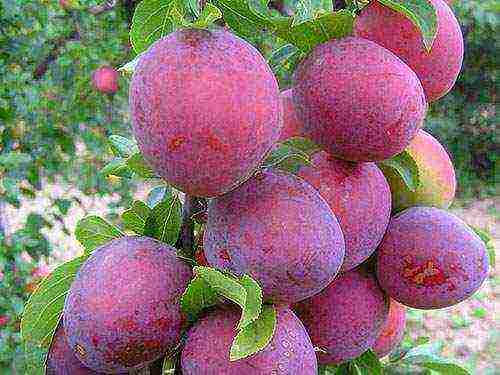 Small tree, not tall. Feels great in sunny places. It is growing rapidly. It blooms in mid-April. Begins to bear fruit for 4 - 5 years. Fruit weight reaches up to 40 grams. The fruits are weighty, large. Inside they have yellow-green flesh. Can be harvested for the winter. Up to 35 kg are usually removed from one tree. fruits. Ripens early, in early July. Withstands frost. Self-fertile variety, other varieties are needed for pollination. Endured in frost in the spring.
Small tree, not tall. Feels great in sunny places. It is growing rapidly. It blooms in mid-April. Begins to bear fruit for 4 - 5 years. Fruit weight reaches up to 40 grams. The fruits are weighty, large. Inside they have yellow-green flesh. Can be harvested for the winter. Up to 35 kg are usually removed from one tree. fruits. Ripens early, in early July. Withstands frost. Self-fertile variety, other varieties are needed for pollination. Endured in frost in the spring.
Not very resistant to dry soil, grows poorly without cultivation.
Cherry Gek
 Rounded, fast-growing stocky tree, with a crown of medium density. The flowers are medium, with white petals. Bears fruit in the second half of summer. The fruits are large, weighing up to 35 grams, have a sweet and sour taste. Outside, the fruits are yellow, elastic to the touch. Inside are dark yellow. The bones are difficult to separate. The variety is suitable for all types of consumption. High-yielding, winter-hardy.Increased resistance to adverse conditions. Cross-pollinated with surrounding trees.
Rounded, fast-growing stocky tree, with a crown of medium density. The flowers are medium, with white petals. Bears fruit in the second half of summer. The fruits are large, weighing up to 35 grams, have a sweet and sour taste. Outside, the fruits are yellow, elastic to the touch. Inside are dark yellow. The bones are difficult to separate. The variety is suitable for all types of consumption. High-yielding, winter-hardy.Increased resistance to adverse conditions. Cross-pollinated with surrounding trees.
Cherry plum Kuban comet
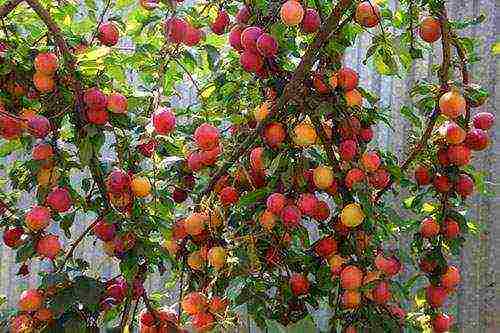 Weak tree. The crown is round, flat, with sparse foliage. Each bud blooms with two medium-sized flowers. It blooms vigorously. After flowering, it is recommended to feed this variety with compost. The ovary appears in June. Fruits turn red by the end of July. Without props, branches can break from the weight. Full collection in August. The fruits are large - up to 45 grams. Delicious, ripe. The color is red, burgundy. The pulp is yellow, has an apricot flavor. The variety is well transportable. There are many advantages. Disadvantage - it ripens unevenly.
Weak tree. The crown is round, flat, with sparse foliage. Each bud blooms with two medium-sized flowers. It blooms vigorously. After flowering, it is recommended to feed this variety with compost. The ovary appears in June. Fruits turn red by the end of July. Without props, branches can break from the weight. Full collection in August. The fruits are large - up to 45 grams. Delicious, ripe. The color is red, burgundy. The pulp is yellow, has an apricot flavor. The variety is well transportable. There are many advantages. Disadvantage - it ripens unevenly.
Cherry plum Rubinovaya
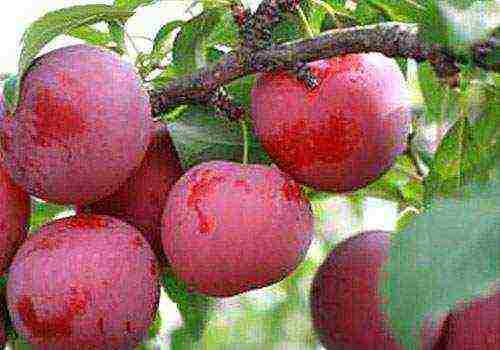 Large, dark red, ruby fruits, up to 30 gr. The fibrous pulp is sweet and sour, with aroma. A tree of medium height with a wide, lush, oval crown. Ripens early. It sings in early July. Withstands frosty weather, summer dryness. The variety is resistant to any temperature extremes.
Large, dark red, ruby fruits, up to 30 gr. The fibrous pulp is sweet and sour, with aroma. A tree of medium height with a wide, lush, oval crown. Ripens early. It sings in early July. Withstands frosty weather, summer dryness. The variety is resistant to any temperature extremes.
Cherry plum Skoroplodnaya
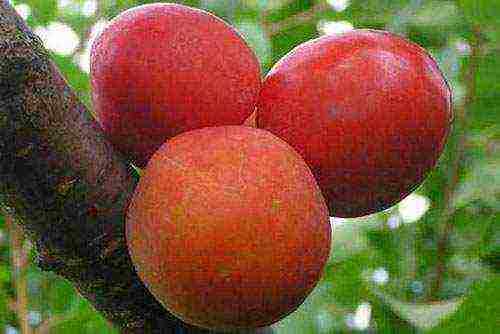 The variety was imported from China. Fruiting in the second year after planting. Despite its low altitude, it overcomes frosts not only in the middle zone, but also in the North. Resistant variety. A lot of vitamin C. Broad crown, dark foliage. It sings in late summer.
The variety was imported from China. Fruiting in the second year after planting. Despite its low altitude, it overcomes frosts not only in the middle zone, but also in the North. Resistant variety. A lot of vitamin C. Broad crown, dark foliage. It sings in late summer.
Alycha Vladimirskaya comet
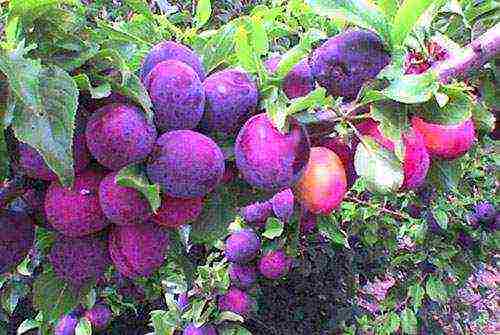 A tree with a wide crown, sparse leaves. The fruits are oval, pointed, burgundy. Inside there is a dark orange sweet and sour pulp. Harvesting tree, ripens in July.
A tree with a wide crown, sparse leaves. The fruits are oval, pointed, burgundy. Inside there is a dark orange sweet and sour pulp. Harvesting tree, ripens in July.
Cherry Seedling Rocket
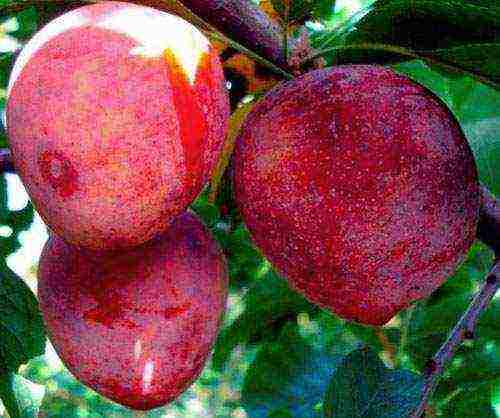 Keeps frost down to -35, medium-sized tree. The crown is dense, spreading, the fruits are large, up to 30 grams. Red color, rounded, pointed. The yield is high.
Keeps frost down to -35, medium-sized tree. The crown is dense, spreading, the fruits are large, up to 30 grams. Red color, rounded, pointed. The yield is high.
Alycha Timiryazevskaya
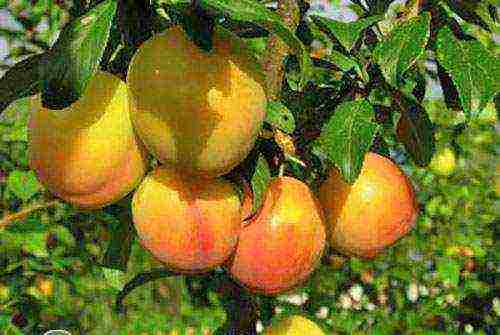
The variety was bred at the Timiryazev Institute. Cherry plum grows up to 3 meters, the crown is wide, spreading. Cone-shaped tree, sparse foliage. It does not show fungal diseases. Fruits are small, light red, conical. Loose inside, bones are easily separated. Harvest up to 30 kg.
Cherry plum variety Gold of the Scythians
 Bred by the Academy named after K.A. Timiryazev. Medium height, about 2 meters, shrub type. The crown is spreading, rounded. The leaves are large, elongated, light green, serrated. The flowers are white when blooming. The fruits are large, up to 36 grams. The pulp is yellow, fibrous. Melting sweet and sour taste. A universal variety of cherry plum Zlato Scythians, suitable for everything. Begins to bear fruit for 4 years. Produces a good annual harvest. Delicious fruits ripen early. It tolerates frost well.
Bred by the Academy named after K.A. Timiryazev. Medium height, about 2 meters, shrub type. The crown is spreading, rounded. The leaves are large, elongated, light green, serrated. The flowers are white when blooming. The fruits are large, up to 36 grams. The pulp is yellow, fibrous. Melting sweet and sour taste. A universal variety of cherry plum Zlato Scythians, suitable for everything. Begins to bear fruit for 4 years. Produces a good annual harvest. Delicious fruits ripen early. It tolerates frost well.
Flaws. It does not pollinate itself. It is necessary to plant other varieties for pollination. Poorly tolerates transportation.
All the listed varieties of cherry plum, which are good for the Moscow region, can withstand cold and wind. With minor features and deviations. In general, they are well adapted to our central Russia. They give good yields. They can be eaten, canned, transported. They are convenient, useful, and beneficial. These varieties of cherry plum have long taken root in our land. Our summer residents and gardeners love to plant them.
About cherry plum varieties in central Russia - video


